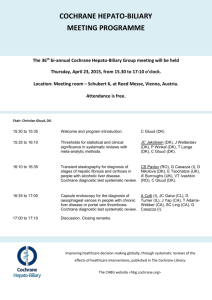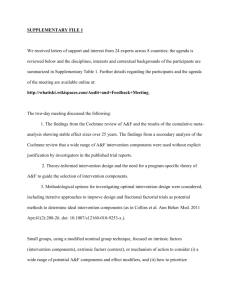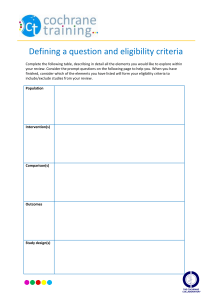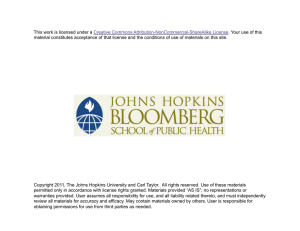chbg newsletter - Cochrane Hepato
advertisement
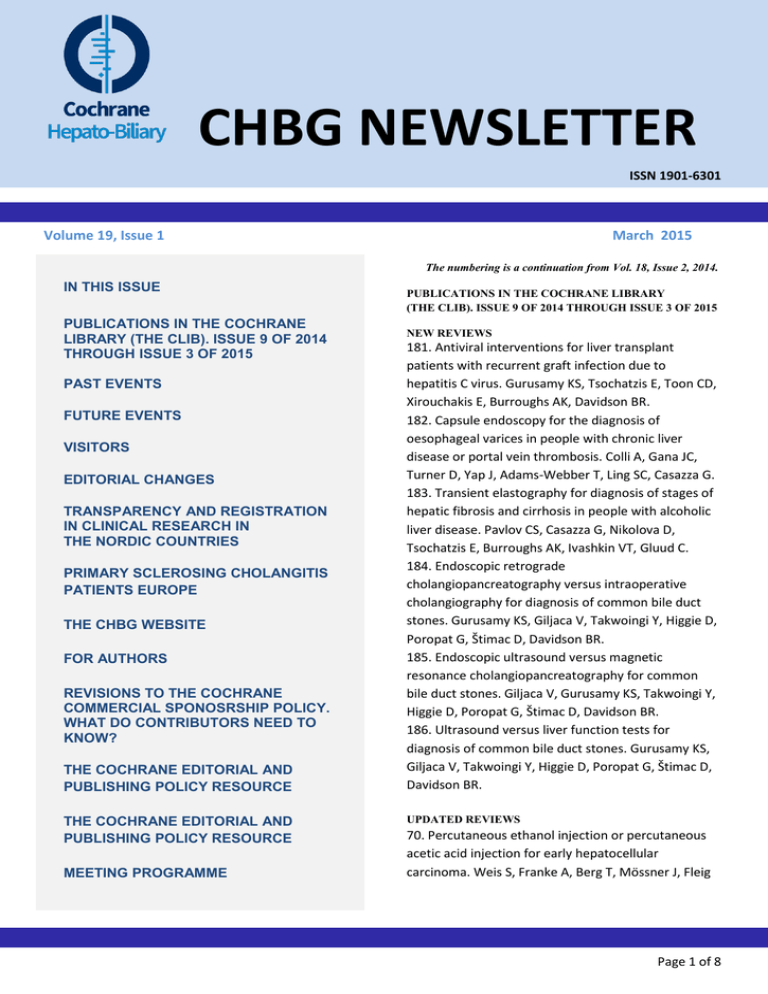
CHBG NEWSLETTER ISSN 1901-6301 Volume 19, Issue 1 March 2015 The numbering is a continuation from Vol. 18, Issue 2, 2014. IN THIS ISSUE PUBLICATIONS IN THE COCHRANE LIBRARY (THE CLIB). ISSUE 9 OF 2014 THROUGH ISSUE 3 OF 2015 PAST EVENTS FUTURE EVENTS VISITORS EDITORIAL CHANGES TRANSPARENCY AND REGISTRATION IN CLINICAL RESEARCH IN THE NORDIC COUNTRIES PRIMARY SCLEROSING CHOLANGITIS PATIENTS EUROPE THE CHBG WEBSITE FOR AUTHORS REVISIONS TO THE COCHRANE COMMERCIAL SPONOSRSHIP POLICY. WHAT DO CONTRIBUTORS NEED TO KNOW? THE COCHRANE EDITORIAL AND PUBLISHING POLICY RESOURCE THE COCHRANE EDITORIAL AND PUBLISHING POLICY RESOURCE MEETING PROGRAMME PUBLICATIONS IN THE COCHRANE LIBRARY (THE CLIB). ISSUE 9 OF 2014 THROUGH ISSUE 3 OF 2015 NEW REVIEWS 181. Antiviral interventions for liver transplant patients with recurrent graft infection due to hepatitis C virus. Gurusamy KS, Tsochatzis E, Toon CD, Xirouchakis E, Burroughs AK, Davidson BR. 182. Capsule endoscopy for the diagnosis of oesophageal varices in people with chronic liver disease or portal vein thrombosis. Colli A, Gana JC, Turner D, Yap J, Adams-Webber T, Ling SC, Casazza G. 183. Transient elastography for diagnosis of stages of hepatic fibrosis and cirrhosis in people with alcoholic liver disease. Pavlov CS, Casazza G, Nikolova D, Tsochatzis E, Burroughs AK, Ivashkin VT, Gluud C. 184. Endoscopic retrograde cholangiopancreatography versus intraoperative cholangiography for diagnosis of common bile duct stones. Gurusamy KS, Giljaca V, Takwoingi Y, Higgie D, Poropat G, Štimac D, Davidson BR. 185. Endoscopic ultrasound versus magnetic resonance cholangiopancreatography for common bile duct stones. Giljaca V, Gurusamy KS, Takwoingi Y, Higgie D, Poropat G, Štimac D, Davidson BR. 186. Ultrasound versus liver function tests for diagnosis of common bile duct stones. Gurusamy KS, Giljaca V, Takwoingi Y, Higgie D, Poropat G, Štimac D, Davidson BR. UPDATED REVIEWS 70. Percutaneous ethanol injection or percutaneous acetic acid injection for early hepatocellular carcinoma. Weis S, Franke A, Berg T, Mössner J, Fleig Page 1 of 8 March 2015 Volume 18, Issue 2 WE, Schoppmeyer K. 71. Branched-chain amino acids for people with hepatic encephalopathy. Gluud LL, Dam G, Les I, Córdoba J, Marchesini G, Borre M, Aagaard NK, Vilstrup H. NEW AND UPDATED PROTOCOLS 283. External beam radiotherapy for unresectable hepatocellular carcinoma. Abdel-Rahman OM, Elsayed Z. 284. Yttrium-90 microsphere radioembolisation for unresectable hepatocellular carcinoma. AbdelRahman OM, Elsayed Z. 285. Pharmacological treatments for primary sclerosing cholangitis: a network meta-analysis. Gurusamy KS, Saffioti F, Toon CD, Tsochatzis E, Davidson BR, Thorburn D. 286. Acetyl-L-carnitine for patients with hepatic encephalopathy. Martí-Carvajal AJ, Gluud C, ArevaloRodriguez I, Rincón-Martínez LM. 287. Carvedilol versus non-selective beta-blockers for portal hypertension in cirrhosis. Hobolth L, Bendtsen F, Gluud LL. 288. Terlipressin versus other vasoactive drugs for hepatorenal syndrome. Israelsen M, Krag A, Gluud LL. 289. Banding ligation versus sham or no intervention for primary prophylaxis of oesophageal variceal bleeding in children. Gana JC, Cifuentes LI, Cerda J, Villarroel del Pino LA, Peña A, Rivera-Cornejo M. 290. Nutrition support in hospitalised adults at nutritional risk. Feinberg J, Nielsen EE, Gluud C, Lindschou J, Kondrup J, Jakobsen JC. 291. Rifaximin for people with hepatic encephalopathy. Kimer N, Krag A, Bendtsen F, Møller S, Gluud LL. 292. Sclerotherapy versus sham or no intervention for primary prophylaxis of oesophageal variceal bleeding in children. Gana JC, Cifuentes LI, Cerda J, Villarroel del Pino LA, Peña A, Rivera-Cornejo M. 293. Tyrosine kinase inhibitors for unresectable hepatocellular carcinoma in adults. Rossi RE, Pozzi R, Gonzalez-Lorenzo M, Kwag KH, Conte D, Cecco S, Banzi R, Moja L, Baldo P. 294. Ultrasonography for diagnosis of cirrhosis in people with alcoholic liver disease. Pavlov CS, Casazza G, Pavlova M, Nikolova D, Tsochatzis E, Liusina E, Gluud C. 295. Vitamin D supplementation for chronic liver diseases. Bjelakovic G, Nikolova D, Bjelakovic M, Gluud C. 296. Immunosuppressive regimens for liver transplantation: a network meta-analysis. Gurusamy KS, Tsochatzis E, Thorburn D, Davidson BR. 297. Management of people with early or very early stage hepatocellular carcinoma: a network metaanalysis. Gurusamy KS, Tsochatzis E, Thorburn D, Davidson BR. 298. Management of people with intermediate-stage hepatocellular carcinoma: a network meta-analysis. Gurusamy KS, Tsochatzis E, Thorburn D, Davidson BR. 299. Pharmacological treatments for primary biliary cirrhosis: a network meta-analysis. Gurusamy KS, Tsochatzis E, Davidson BR, Thorburn D. 300. Treatments for hereditary haemochromatosis: a network meta-analysis. Gurusamy KS, Tsochatzis E, Thorburn D, Davidson BR. 301. Pharmacological interventions for alcoholic liver disease (alcohol-related liver disease): a network meta-analysis. Gurusamy KS, Tsochatzis E, Thorburn D, Davidson BR. 302. Pharmacological treatments for acute hepatitis B infection: a network meta-analysis. Gurusamy KS, Tsochatzis E, Thorburn D, Davidson BR. 303. Pharmacological treatments for acute hepatitis C infection: a network meta-analysis. Gurusamy KS, Thorburn D, Tsochatzis E, Davidson BR. 304. Pharmacological treatments for chronic hepatitis B liver disease: a network meta-analysis. Gurusamy KS, Tsochatzis E, Thorburn D, Davidson BR. 305. Pharmacological treatments for chronic hepatitis C liver disease: a network meta-analysis. Gurusamy S, Toon CD, Thorburn D, Tsochatzis E, Davidson BR. 306. Pharmacological treatments for acute hepatitis C infection: a network meta-analysis. Gurusamy KS, Page 2 of 8 March 2015 Volume 18, Issue 2 Thorburn D, Tsochatzis E, Davidson BR. 307. Sclerotherapy versus beta-blockers for primary prophylaxis of oesophageal variceal bleeding in children. Gana JC, Cifuentes LI, Cerda J, Villarroel del Pino LA, Peña A, Torres-Robles R. NEW REGISTERED TITLES 486. Sofosbuvir for chronic hepatitis C infection. Sultan W, Hussein H, Garg SK, Zidan EM, Abo El-Nour F, Samara M, Nabhan AF. 487. Physical exercise versus no intervention or other interventions for patients with cirrhosis. Rinnov A, Aamann L, Dam G, Vilstrup H, Gluud LL. 488. Treatments for hereditary haemochromatosis: a network meta-analysis. Gurusamy KS, Tsochatzis E, Thorburn D, Davidson BR. 489. Serological tests for primary biliary cirrhosis. Aralica M, Giljaca V. 490. Zinc for hepatic encephalopathy. Dadabhai AS, Saberi B, Akhuemonkhan E. 491. Prophylactic antibiotics for acute liver failure. Eliakim-Raz N. 492. L-ornithine L-aspartate for people with hepatic encephalopathy. Vilstrup H, Morgan MY, Stokes CS, Dam G, Gluud LL. PAST EVENTS 22ND COCHRANE COLLOQUIUM, HYDERABAD, INDIA. SEPTEMBER 21 TO 26, 2014 Cochrane colloquia provide an annual forum where Collaboration staff come together to share ideas and information, hold important meetings, and learn. The Hyderabad colloquium was extremely well organised and the programme was busy as usual, providing all participants from around the world the opportunity to learn more about the latest evidence and methodology of Cochrane reviews. The social and cultural programme was fun and all events were well attended. DIAGNOSIS AND PROGNOSIS: CLINICAL AND RESEARCH PROBLEMS, GARGNANO, LAGO DI GARDA, ITALY, OCTOBER 8 TO OCTOBER 12, 2014 This was a basic residential course, aimed to provide the tools for understanding the methodology underlying diagnostic test accuracy and prognostic studies and for preparation of diagnostic test accuracy reviews. The course was organized for a fourth time by Centro Interuniversitario “Thomas C. Chalmers”, Italy; Università degli Studi di Milano, Facoltà di Medicina e Chirurgia, Cattedra di Gastroenterologia, Milan, Italy; Fondazione IRCCS “Ca Granda -Ospedale Maggiore Policlinico”, U.O.C. di Gastroenterologia 2; The Copenhagen Trial Unit, Centre for Clinical Intervention Research, and The Cochrane Hepato-Biliary Group, Rigshospitalet, Copenhagen, Denmark; and The Cochrane Multiple Sclerosis Group, Fondazione Istituto Nazionale Neurologico Besta, Milan, Italy. All sessions were in English. There were about 25 participants. The course received very good evaluation, and it is planned to be run again later this year from 20 to 23 of September. Palazzo Feltrinelli, the mansion where the course is run, is on the shores of Garda Lake. 35TH CHBG MEETING DURING THE LIVER® MEETING, BOSTON, MA, USA. NOVEMBER 7 TO NOVEMBER 11, 2014 The 35th bi-annual Cochrane Hepato-Biliary Group (CHBG) meeting, affiliate event at The Liver Meeting®, was run November 10th, 2014, from 6:30pm to 8:00pm, in room ‘Wellesley’ at the Boston Marriott Copley Place, 110 Huntington Avenue, Boston, Massachusetts, USA. The focus of the presentations was chronic hepatitis B and diagnostic test accuracy of transient elastography in people with alcoholic liver disease. We thank all speakers for their interesting and excellent presentations. Page 3 of 8 March 2015 Volume 18, Issue 2 CHBG EXHIBITION STAND DURING THE LIVER® MEETING, BOSTON, MA, USA. NOVEMBER 7 TO NOVEMBER 11, 2014 We thank all people who have visited the CHBG stand and showed interest in our work. CHBG exhibitions have become the meeting place for editorial staff to meet with our collaborators in person and discuss work, provide technical help or advice. FUTURE EVENTS THE INTERNATIONAL LIVER CONGRESS™ 2015 APRIL 22 TO 26 -- VIENNA, AUSTRIA -- THE COCHRANE HEPATO-BILIARY GROUP MEETING AND STAND AT THE EXHIBITION During the congress, the CHBG will run its 36 bi-annual meeting on April 23, at room Schubert 6, Reed Messe, (see programme). The one hour and a half meeting will start at 15:30. All people are heartily welcome. There is no registration fee (see the meeting programme). The exhibition opening hours are from 09:30 to 16:30 Thursday, Friday, and Saturday. Please visit us at stand number 120 C. DIAGNOSTIC ACCURACY STUDIES: CLINICAL AND RESEARCH CHALLENGES. GARGNANO, LAGO DI GARDA, ITALY. SEPTEMBER 20 TO 23 The aim of this international course is to provide the tools for understanding the methodology underlying the diagnostic test accuracy (DTA) studies. At the end of the course, participants will be able to perform critical appraisals of diagnostic accuracy studies, and make extraction and interpretation of data to build DTA systematic reviews with metaanalyses. The basis for the design of a diagnostic accuracy study and of a DTA systematic review protocol will also be provided. General principles - Basic course to expand the methodological basis of the diagnostic research from the point of view of clinical research (to be able to read and report in writing a diagnostic study). Main objectives To critically analyse a diagnostic study (phase 2A), learn how to extract the data, to evaluate the quality of the studies, and to analyse the external validity of the results. The course will end with examination of the participants, which will be group work on a protocol draft. The location of the course is Palazzo Feltrinelli on the shores of the Garda Lake. You are most welcome to contact us for more information. The course programme will also be placed on the CHBG website. THE 23RD COCHRANE COLLOQUIUM, VIENNA, AUSTRIA. OCTOBER 3 TO OCTOBER 7, 2015 This year the colloquium theme is: Filtering the information overload for better decisions. Also this year, a wide and varied program of plenaries, special sessions, research, and workshops will be run. You can find all information regarding the program, submission, registration, social program, and travel to Vienna on the colloquium website (colloquium.cochrane.org/). Early bird registration is available until 22 July 2015. Audience: clinicians and/or researchers interested in appraising the basis of diagnostic and prognostic research. The course will focus mainly on diagnosis. VISITORS Mona H. Ismail, from Saudi Arabia, visited the Editorial Team Office of The CHBG in Copenhagen, Denmark from 2 to 11 of October, 2014. Mona worked on entecavir versus other antiviral drugs for chronic hepatitis B reviews. However, given the parallel between diagnosis and prognosis, and the similarity between their phases, prognosis will also be considered. Chavdar Pavlov, visiting researcher from Moscow, Russia, visited the Editorial Team Office of The CHBG Page 4 of 8 March 2015 Volume 18, Issue 2 in Copenhagen, Denmark from 7 to 17 of April 2015. Chavdar worked on three intervention review protocols on alcoholic liver disease. Chavdar did also some work on the “Ultrasonography for diagnosis of cirrhosis in patients with alcoholic liver disease” review. EDITORIAL CHANGES Bodil Als-Nielsen, Denmark, left the CHBG Editorial Team February 2015 due to other work obligations. We thank Bodil for all her hard work and contribution as an editor from 2008 to February 2015. Theis Lange, Denmark, joined the CHBG Editorial Team as a statistical editor in February 2015. Theis is a biostatistician, educated at University of Copenhagen and London School of Economics. Theis is Associate Professor in biostatistics at the University of Copenhagen. He is also the Head of the Section of biostatistics which has 30 staff members. His research involves theoretical and methodological work on statistics as well as a wide range of applied collaborations with medical doctors and epidemiologists. Theis’s methodological work is focused on causal inference, i.e., a formal framework for addressing cause and effect from observational data as well as trial data. Theis’s applied collaborations span from smaller randomised clinical trials to complex longitudinal observational studies. He was awarded the Kenneth Rothman Prize 2012 for the best paper in Epidemiology http://journals.lww.com/epidem/Citation/2012/0900 0/Theis_Lange,_Winner_of_the_Kenneth_Rothman.1. aspx Heartily welcome to the CHBG, Theis! TRANSPARENCY AND REGISTRATION IN CLINICAL RESEARCH IN THE NORDIC COUNTRIES The Nordic Trial Alliance Working Group 6 on Transparency and Registration: Kristján Erlendsson, Iceland; Mika Scheinin, Finland; Steinar Aamdal, Norway; Valentina Cabral Iversen, Norway; Siv Mørkved, Norway; Mia Englund, Sweden; Eva Carin Jacobson, Sweden; Maria Skoog, Denmark; Jenna Maria Saarimäki, Denmark; Christian Gluud, Denmark. Background Stakeholders in clinical research have been requesting increased transparency of clinical research data for decades. Despite this, evolution of transparency has been slow. Since 2000, more and more clinical researchers, medical journal editors, pharmaceutical and medical devices companies, national and regional governments, charitable foundations and regulatory agencies have emphasized the need for improved transparency regarding clinical research data. Complete trial registration (before study start) and access to summary results and individual participantlevel research data are essential social prerequisites to get the full benefits from biomedical research. Meta-analysis is a powerful aid to rational decisionmaking, but it becomes possible only if all trial results are available for use. Thus, to aid more ‘personalised’ treatment decisions, both aggregated summary results for traditional meta-analysis and individual participant-level research data for specific subgroup analyses are essential. Objectives Working Group 6 (WP6) on Transparency and Registration was formed in 2013 as part of the Nordic Trial Alliance’s (NTA) initiative for increasing collaboration among the Nordic countries and competitiveness in clinical trials, following the Nordic Council of Ministers’ and NordForsk’s ambitions. The NTA reviews issues of transparency and registration of clinical research and their data; maps and develops ‘best practices’ for public, prospective registration and public reporting of clinical trials of all interventions; and maps and develops ‘best practices’ for public upload of depersonalised individual participant data after the publication of study reports. Page 5 of 8 March 2015 Volume 18, Issue 2 The NTA WP6 recommendations represent attempts to balance the interests of the public; the patients; the trial participants; the regulatory authorities; and the pharmaceutical, medical devices, and biotechnology industries. By making the Nordic region a leading force in transparency and trial registration, the NTA hopes to consolidate and expand the trustworthiness of clinical research conducted in the Nordic countries. Nordic collaboration and competitiveness in clinical trials can increase in global context. Trial registration serves to build knowledge and availability of ongoing research, serves to prevent selective reporting, publication bias, and unnecessary duplication of research. Trial registration shall be followed by result and data reporting. So, we recommend: Registration of all clinical trials irrespective of type of intervention, phase, disease or condition before inclusion of the first participant, including the full protocol in one of the primary registries approved by the WHO or in the ClinicalTrials.gov registry. Expansion of the current WHO-defined 20 items of trial registration with inclusion of a monitoring plan, statistical analysis plan, data management plan, safety reporting procedures, and conflicts of interest. Making trial registration a condition for ethical approval. Creation of harmonised legislation in the Nordic countries requiring posting of the summary results at the trial site registry. The legislation should be developed in close collaboration with all stakeholders. Better compliance with study reporting practices according to the CONSORT statement. Making full clinical trials reports and the analysed data sets supporting the results available at the same time. Public upload of depersonalised (or in exceptional cases anonymised) individual participant data (i.e., the analysed data set as well as essential source or raw data) after publication of the full report of the trial. Setting up a Nordic ‘transparency council’ to become a central, trusted public party for keeping the identification key for depersonalised data sets as well as to grant waivers to the general requirement to upload trial results within 12 months as well as the requirement to upload depersonalised individual participant data. Introduction of harmonised legislation in the Nordic countries in collaboration or as individual nations to govern the suggested steps of trial registration and increased transparency for both investigator-initiated and industry-initiated clinical research. Legal definition of attempts to re-identify depersonalised or anonymised data as an unlawful act. Future aspects There are hurdles to clear in order to develop an effective data-sharing culture. We propose, in line with the recent Institute of Medicine’s (IOM) report (Sharing Clinical Trial Data: Maximizing Benefits, Minimizing Risk; released January 14, 2015; see http://www.iom.edu/Reports/2015/Sharing-ClinicalTrial-Data.aspx), to modify and supplement trial registries in order to accommodate better transparency, and store and share trial data in a responsible and useful manner. Apart from technical matters, we urge a change in how we think about data. They are not one’s personal property but should be viewed as a gift to the research community and, therefore, we have a responsibility to make use of this gift and turn it into profits for the giver ̶ the trial participant. This profit should materialize in better knowledge and better Page 6 of 8 March 2015 Volume 18, Issue 2 interventions for diagnosis, prevention, treatment, and care. The aim is to facilitate a system whereby anyone looking for trials related to a certain condition can access a one-stop search portal which will search within and across registers, and provide a shortlist of potential trials and their details within seconds. We wish to make the Nordic region a frontrunner in reestablishing people’s trust in clinical research. By creating harmonised laws for registration and transparency, the Nordic region shall regain a leading position in ethical conduct of clinical research. The full report of NTA’s working group 6, “REPORT ON TRANSPARENCY AND REGISTRATION IN CLINICAL RESEARCH IN THE NORDIC COUNTRIES”, is published online at NTA’s website: http://nta.nordforsk.org/projects/FINALNTAWPG3003 2015.pdf PRIMARY SCLEROSING CHOLANGITIS PATIENTS EUROPE Primary Sclerosing Cholangitis Patients (PSC) Europe is a pan-European, disease-specific patient organisation, often complimentary to the already existing, frequently organ-based patient associations. We are a non-profit, 100% volunteer-based. All people with PSC need access to good information about PSC in their native language, no matter the disease prevalence in any given country. PSC Europe publishes ‘layman’ versions of scientific articles and translates them in as many European languages as possible. So far, we reported on ‘Groundbreaking PSC research' and on 'norUrso'. During EASL /ILC we would like to connect with PSC researchers to see how we can collaborate, e.g. by enabling them to have better chances of getting (EU) grants. We are also looking for European patient associations that wish to focus on PSC. If there is no PSC patient representation in your country yet, we will have a webpage available within 24 hours, so volunteers can start. Please check out our website PSCPatientsEurope.org, follow us on twitter @PSCPatientsEur, or email our Founder & President, Marleen Kaatee: marleen@pscpatientsEurope.org . We are looking forward hearing from you! THE CHBG WEBSITE The CHBG website [hbg.cochrane.org] will be further updated by the end of the year following Cochrane rebrand initiative. Both Cochrane (the former Cochrane Collaboration) and Cochrane Hepato-Biliary Group have now new logos. We encourage you to follow the progress of our work and learn about the new developments from the cochrane.org website. REVISIONS TO THE COCHRANE COMMERCIAL SPONOSRSHIP POLICY. WHAT DO CONTRIBUTORS NEED TO KNOW? Cochrane has always sought to provide independent healthcare information. Research has shown that reviews that are funded or partially funded by industry are likely to overestimate benefits and underestimate harms. Sponsorship of drugs and device studies by manufacturers is associated with favourable results and conclusions for the sponsor’s products, compared to sponsorship by other sources. The analyses suggest that the existence of industry bias cannot be explained by standard ‘Risk of bias’ assessments. There are four key points to this policy: Page 7 of 8 March 2015 Volume 18, Issue 2 No author can be employed of pharmaceutical companies or similar organisations (such as manufacturers of healthcare products); The majority of authors and lead authors on a Cochrane Review should not have any conflicts of interest relevant to the review topic; Authors of Cochrane reviews cannot be funded by pharmaceutical companies or industry to undertake reviews; No part of the Cochrane Review process can be funded by pharmaceutical companies or similar organisations. FOR AUTHORS Authors of CHBG reviews and contributors are requested to read relevant ‘Information for authors’ on [hbg.cochrane.org] in addition to [cochrane.org] website. On the CHBG website [hbg.cochrane.org], you will find among others: - recommended text for bias risk evaluation. - core outcomes for chronic hepatitis B (CHB) virus infection - core outcomes for chronic hepatitis C (CHC) virus infection - trial sequential analysis - references to publications used in CHBG protocols, and other useful information. THE COCHRANE EDITORIAL AND PUBLISHING POLICY RESOURCE Review authors are advised to read carefully the information provided at www.cochrane.org/editorialand-publishing-policy-resource and encompassing permissions to reuse material from Cochrane sources, reprints of Cochrane Reviews, correspondence, dissemination, and impact, feedback, dissemination, translation and alike. so, from the Cochrane Editorial Unit. Please read the Cochrane co-publication policy on these issues. The Cochrane Hepato-Biliary Group (The CHBG) Newsletter is written, edited, and published in electronic and paper format by Dimitrinka Nikolova and Christian Gluud at The CHBG Editorial Office in Copenhagen, Denmark. It is issued twice a year and is also distributed for free world-wide to all people on The CHBG members’ list who have contributed, are contributing, or have shown interest in the work of The CHBG or in this CHBG Newsletter. The purpose with The CHBG Newsletter is to inform its readers about activities of The CHBG. Editorial CHBG staff at The CHBG Editorial Office Christian Gluud, Co-ordinating & Criticism Editor, E-mail: cgluud@ctu.dk; Dimitrinka Nikolova, Managing Editor, E-mail: dimitrinka.nikolova@ctu.dk; Sarah Louise Klingenberg, Trials Search Coordinator, E-mail: slk@ctu.dk Postal address The Cochrane Hepato-Biliary Group/ Copenhagen Trial Unit, Centre for Clinical Intervention Research Department 7812, Rigshospitalet, Blegdamsvej 9, Copenhagen Ø, DK-2100 Tel. +45 3545 7169 or +45 3545 7175 Fax +45 3545 7101 Web site: hbg.cochrane.org Visiting address Department 7812, Tagensvej 22, 2nd floor, Copenhagen N, DK-2200 Cochrane review authors are not allowed to send manuscripts of their Cochrane reviews for publication in paper journals without obtained permissions to do Page 8 of 8
